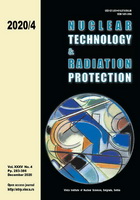
NATURAL RADIO ACTIVITY AND RADIOLOGICAL HAZARD OF RED-CLAY BRICK PRO DUCED IN SHANGLUO, CHINA

Vol.
XXXV, No. 4, Pp. 283-386
December 2020
UDC 621.039+614.876:504.06
ISSN 1451-3994
Pages: 347-353
Authors: Sukai Zhuang and Xinwei LuAbstract
The radiological hazard of building materials originating from clay, rock and other mineral wastes has attracted more attention because they contain natural radionuclides (241Ra, 232Th, and 40K). The activity concentration of radionuclides in red-clay brick samples obtained from three different brickyards in Shangluo, China was measured. Various indexes, including radium equivalent activities, Raeq, external hazard index, Hex, internal hazard index, Hin, indoor air absorbed dose rate, D, and annual effective dose, AED, of the aforementioned radionuclides in the bricks were used to assess the radiation hazard for people. The average activity concentrations of 226Ra, 232Th, and 40K were respectively 34.5 ± 1.9, 62.5 ± 2.1, and 713.7 ± 19.8 Bqkg-1 for the studied red-clay bricks. The Raeq values of the red-clay brick samples varied from 167.0 to 184.7 Bqkg-1, which are lower than the limit of 370 Bqkg-1. Moreover, the activity concentrations of natural radionuclides in unfired brick, clay and coal were also determined and the results were compared with that in the red-clay brick samples. This study shows that the red-clay bricks produced in Shangluo, China can be used safely in construction industries.
Key words: natural radioactivity, radium equivalent activity, radiological hazard, red-clay brick
FULL PAPER IN PDF FORMAT (330 KB)